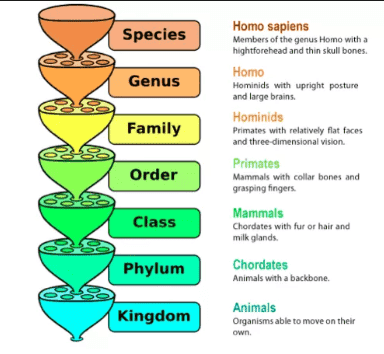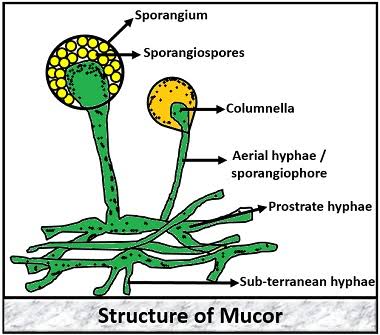ANTHOCEROS - CLASSIFICATION, STRUCTURE OF THE GAMETOPHYTE, REPRODUCTION, SPOROPHYTE
A.CLASSIFICATION
Divisions-Bryophyta
Class-Anthocerotopsida
Order-Anthocerotales
Family-Anthocerotaceae
Genus-Anthoceros
The genus anthoceros comprises about 200 species and widely distributed all over the world. The species of anthoceros is cosmopolitan, but occur mainly in temperate and trophical regions. All the species are found to grow in moist and shady places on ditches, rocks etc.
About 25 species of anthoceros have been reported from india. Of these the common species are - A.erectus , A.himalyansis, A.crsipulus etc.
B.STRUCTURE OF THE GAMETOPHYTE
1. EXTERNAL STRUCTURE- The plant body i.e., the Gametophyte is small yellowish-green or dark-green dorsiventrally flattened, lobed thallus. The lobes with divided margins overlap. The lobes are thick and fleshy and generally more or less divided to form an irregularly lobed and folded margin. The species of anthoceros exhibit differential hibits. Some remain prostrate on the substratum , whereas the thallus of some species remains slightly raised above the substratum. The upper surface of the thallus is smooth and velvety. Frim the lower surface of the thallus, numerous unicellular , unicellular, smooth walled rhizoids occur.
 |
| Source Wikipedia |
 |
| Source Wikipedia |
2.INTERNAL STRUCTURE- Internally the thallus is several layer thick and without a midrib. There is no tissue differentiation. The entire thallus consists of soft parenchymatous cells. The cells are uniform and compact. There is no intercellular spaces or air chamber or airpores. In some species, a stomata like pore open towards the ventral surface which are known as slime pores. The slime pores leads towards a large cavity, filled with mucillage which is known as mucillage cavity. Very often these mucillage cavities inhibited by nostoc colonies. The cavity containing nostoc colonies are visible to the naked eye as small, deep blue green rounded spots on the ventral side of the thallus.
 |
| Source Wikipedia |
C.REPRODUCTION
Anthoceros reproduces by both Vagetative and sexual process-
1.Vagetative Reproduction- Vagetative Reproduction takes place by the following process-
(a) Fragmentation- The cells in the basal older portion of the thallus die and disorganize. When the progressive decay and the death of the cell reaches the branching region of the thallus lobes become separated. Each separated lobe by continuous apical growth grows into new thallus.
(c) Tubers- Certain species of Anthoceros exposed to draught regularly develop rounded, marginal thicknings called tubers. With the approach of dry season the thallus dies leaving behind the tubers. The tubers tides over the adverse condition for growth, each tubers develops into a new plant.
(d) Persistent growth apices- In A.pearsoni and A.fusiformis , only the apices persists through the long summer draught and resume growth only with the return of favourable condition ( Campbell ). With the continuous growth the cell of persistent apex, a new thallus develops.
(e) Apospory- Schwarzenbach (1926) and Lang (1901) reported that Anthoceros thallus arise from the unspecialised cells of the various part of the sporangium particularly the intercalary meristematic zone, Sub-epidermal and sporogenous regions of the capsule. The thallus is produced directly from the Vagetative cells of the slorangium. This phenomenon is called apospory.
2.Sexual Reproduction-
Anthoceros may be homothallic (monoecious) or hetrothallic (dioecious). In homothallic species, Anthredia mature early i.e., they are protandrous. Sex organs deeply embedded in the thallus.
(a) Anthredia- Anthredia are devoped in clusters from the Hypodermal cells of the thallus and are enclosed in and roofed over by anthredial chamber. Mature anthredium is a club-shaped or pouch like body borne upon a more or less slender stalk composed of four or more rows of cells. Anthredium jacket composed of a single layer of cell, with in the jacket there lies numerous androcyte i.e., sperm mother cells, each of which forms an antherozoids i.e., sperm. Mature sperms are linear and biflagellate.
 |
| Source Wikipedia |
On maturity of the Anthredia, the roof of anthredial chamber ruptures exposing thereby the Anthredia. Then after absorbing water the anthredial wall cracks, as a result sperm are liberated to the surrounding film of water.
 |
| Source Wikipedia |
(c) Fertilization- At the time of fertilization one of the antherozoids enter through the neck and fertilizes the egg. As a result a zygote i.e., oospore is formed. With the formation of zygote, diploid sporophytic generation begins.











0 Comments
If you have any query let me know.